JB Khanna Pictures: With devotion, one can create a legacy
For JB Khanna Pictures, devotional pictures are more than images, they are cultural artefacts. As the family business enters its digital age, it finds balance in colour, technology and memory.
22 Aug 2025 | By Noel D'Cunha
Rajesh Khanna remembers it well: his grandfather handing out five deity prints for a rupee to anyone who stepped into the tiny shop in Parrys Corner. “He said no one should leave empty-handed,” Khanna recalls. Seventy years later, that ethos still underpins JB Khanna Pictures, even as it navigates an industry shaped by pixels and automation.
Currently managed by Khanna along with his brothers Rakesh and Sunil, and their father Girdharilal, who at 79 is still actively involved in daily operations, the company has transformed from a small 1,000-square-foot design house into a hybrid printing operation that produces over 1.5-crore religious images each year. With an archive of more than 40,000 designs and a digital-first future on the horizon, JB Khanna Pictures exemplifies how tradition can thrive in a high-resolution world.
Legacy on paper and press
Founded in 1953 by Jagannath Khanna, the business began with merely artwork and a vision. The firm outsourced printing to Sivakasi and Madurai, controlling design but not production. In 1987, that changed. The family installed its first offset press, taking control of timelines and quality that is so crucial for meeting nationwide demand during festival peaks like Diwali.
Each brother took on a specific role in the business. Khanna managed operations, Rakesh specialised in pre-press, and Sunil coordinated logistics. Sunil also maintains direct contact with all customers in India, taking orders and ensuring their execution. “We grew up in the pressroom,” Khanna recalls, reflecting on the ink-stained apprenticeship that shaped their current responsibilities. He adds, “The personal touch of the Khanna family interacting with customers is our biggest asset.”
Offset brought scale. Religious prints adorned not just homes but temples, shops, and even public vehicles. “During Diwali, we still produce 1.5-crore prints,” Khanna notes. But as demand shifted and inventory management became complex, the brothers knew they needed more than tradition.
Pixels meet piety
Digitisation began in 1997. An Agfa imagesetter and Creo CTP put JB Khanna Pictures among India’s earliest adopters. By 2000, tens of thousands of images had been digitised. Variable formats, instant edits, and reduced wastage became possible. “Even newspapers weren’t this fast back then,” Khanna quips. Investments followed: a Konica Minolta C6100 in 2014, India’s first AccurioJet KM-1e in 2022, and a C14000 in May 2025, the first C14000 in South India. These presses offered not just speed, but colour fidelity essential for devotional work. “You can’t get Krishna’s skin tone wrong,” he says. With high DPI, and the ability to print on metallic films and synthetic stocks, digital offered flexibility offset couldn’t. Digital didn’t replace offset—it complemented it. Large festivals still demand volume, where offset delivers. But short runs, custom orders, or on-demand images? That’s digital territory.
Printing at the speed of faith
The numbers tell the story. Production today is 60% offset and 40% digital, but that’s shifting fast. With a staff of 80 and nearly 20 machines including inkjet and toner presses, JB Khanna Pictures operates with military efficiency. Digital presses run from 9 am to 6:30 pm, with multiple jobs, sometimes ganging up smaller orders into larger print runs.
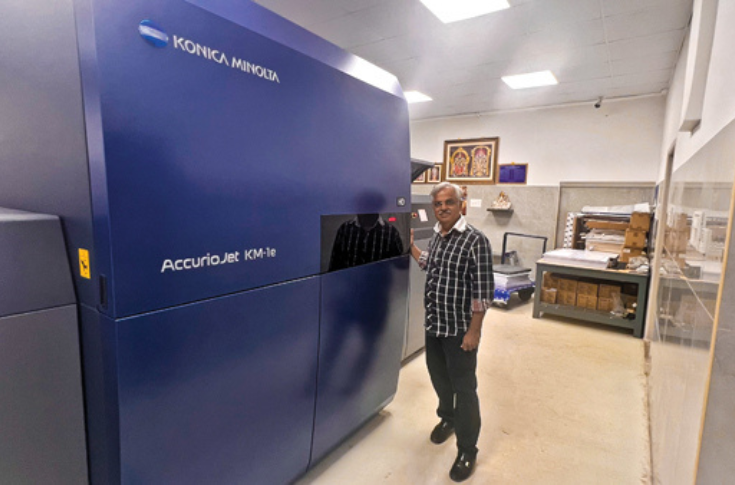
Inkjet handles large-format jobs up to 10 feet, while toner presses like the C14000 cover short-run volumes with lower costs. Post-press, led by Sunil, is equally robust — UV coating, thermal lamination, and even foiling ensure the final print is worship worthy.
Meanwhile, in pre-press, Khanna and Rakesh are old-school perfectionists. “We don’t use ICC profiles. We just know what the colour needs,” Khanna says. Files stay layered, never flattened, and can contain over 200 layers, each carefully adjusted for hue, vibrancy, and emotional tone. A blue shirt? One click. A brighter flame behind the deity? Done in seconds.
Navigating a city of printers
Chennai’s print market is anything but sleepy. With several presses active, competition is fierce. But JB Khanna Pictures’ niche in religious pictures is resilient. “We don’t chase commercial jobs. Our clients are temples, homes, and lorry drivers too,” Khanna says. The firm’s hybrid model provides agility. While others batch-print 500 or more to justify setup time, JB Khanna Pictures offers runs as low as 10. This helps them adapt to buyer needs without overproducing. “We’ve seen new customers come, leave, and return,” he says. “But they remember the print.”
Digital growth is inevitable. Khanna estimates the firm will be fully digital within seven years. A web-fed digital press slated for 2026 will automate more of the workflow and reduce operator load. “Web-fed digital is the future for us,” he says. “Speed, consistency, low waste.”
A quiet sustainability
There’s an unexpected sustainability story here. Devotional prints aren’t disposed of casually, they’re framed, stored, or respectfully retired. “Our waste is almost nothing,” Khanna says. Digital printing, too, supports this ethic: shorter runs, leaner trims, less material loss. Custom-sized papers reduce offcuts. A digital press loses just 3mm per sheet, compared to offset’s 10mm gripper margin and 50-sheet setup waste. “We design for the sheet,” he says. Rakesh’s pre-press techniques and Sunil’s timed dispatches further trim inefficiencies. Even labour management follows this mindful model. No overtime; if needed only during festival peaks. “We want our people to go home on time,” Khanna says. And in that, as in much else, the original Khanna vision still holds.
Faith in every frame
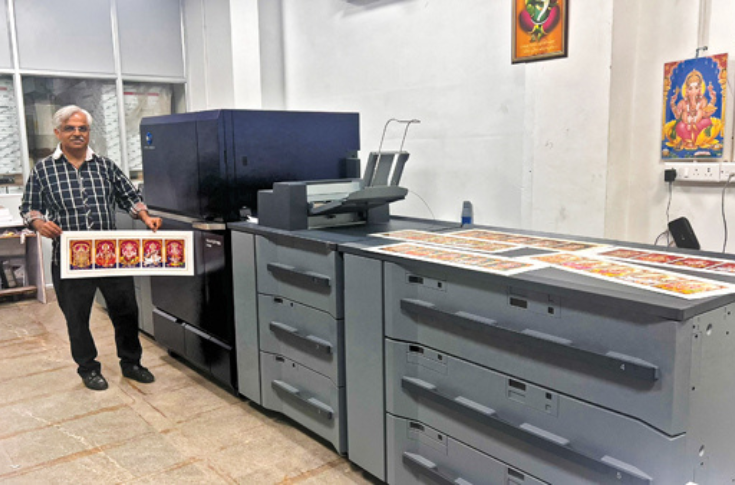
At JB Khanna Pictures, printing isn’t a transaction; it’s an offering. Every image, every shade, every glint of foil has meaning beyond the aesthetic. “We’re not just in printing,” Khanna says, “We’re in emotion. In memory. In home.” With their hybrid pressroom, massive image archive, and unwavering commitment to colour, the Khanna brothers aren’t just keeping a legacy alive, they’re making sure it evolves.








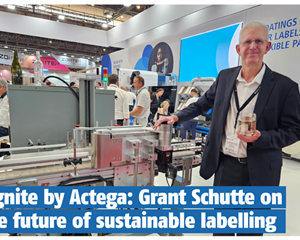
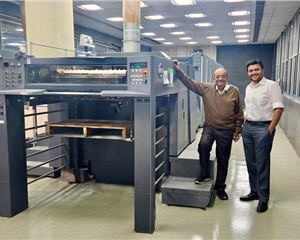

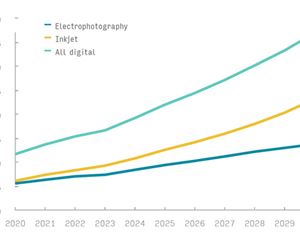
 See All
See All